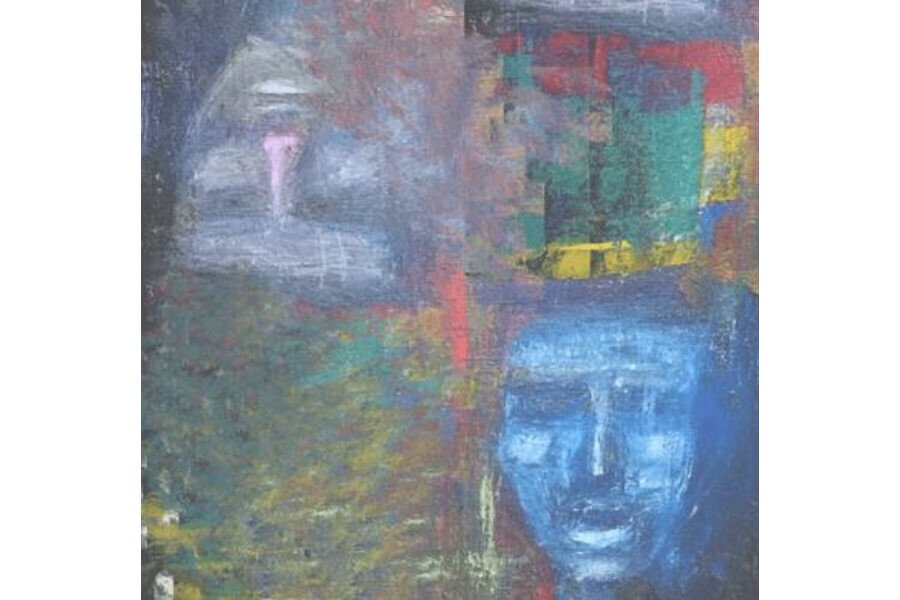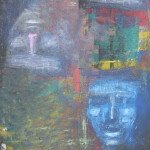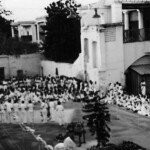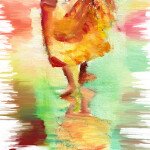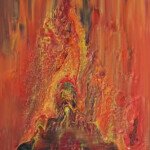This is a translation of my very first article which I wrote in 1981. I had sent it to a German magazine which I used to read during my psychology studies. They published it and later, two more magazines reprinted it. I was asked to keep sending articles. It helped me to stay in India…
“Will you still be able to fit in with us in the West?” asked my sister in a letter (in 1981). I had shared with her some thoughts about life and death with which I had become familiar in India and which I felt made sense. Her question reminded me of what I had almost forgotten, after staying in India for about a year: how life is seen in the West.
First, people there generally do not to think about life and definitely not about death. And in case uninvited questions intrude, for example “Is there a meaning to life?” it is advised to drive them away – with activity, a new outfit or in stubborn cases, with medication. “Depression” is this stubborn state called and, as it is rather common, declared a lifestyle disease. The term ‘disease’ is used, because “healthy” desires, like the desire for wealth, power, fame and sex, are not there any longer. A person is considered healthy, when she tries her best to fulfill those desires, if necessary at the expense of others. After all, everyone has to look after himself first, otherwise he risks being left behind in the race to happiness, the obvious goal of life. And happiness is expected to come when those desires are fulfilled.
This is of course a very rough sketch of the world view in the West. But it encapsulates the essence, when I think of the hectic rat race there on one hand and of the widespread depression on the other, while I am writing down this in the afternoon heat at the Gulf of Bengal.
Here in India I became familiar with a different view of life which is based on intuition and experience and not only on intellectual deduction. And in my view, it does not hamper in any way one’s ability to fit in, including in the West.
‘What is the truth? From where do we come? Where will we go? Why are we here?’ These questions are essential for all of us. In India these questions have been asked since time immemorial, and answers were found. Yet in the West we keep hearing that we can never find answers to those questions and therefore better do not ask them. The Indian Rishis would probably feel compassion for our pitiable state, because we miss out on the meaning of life. Our life is meant to search for the truth and realizing the truth is the crowning accomplishment, not comparable with any worldly achievement.
But it is not easy to realize the truth. It cannot be taught or communicated from one person to another. Everybody has to search and to realize it for himself. Yet India’s wisdom has many hints on how one can experience the truth. The Rishis, who have patiently and intensely searched for it without and within their own being, discovered ‘That’ from where everything emanates, and their insights were handed down over innumerable generations.
Vedanta – the highest philosophy, which is based on three major ancient texts, namely the Upanishads, the Bhagavad Gita, and the Brahmasutras, and which especially Adi Shankara commented upon and spread widely – puts this wisdom simply and clearly:
There is only Oneness, the absolute Truth, which is best described as Sat-Chit-Ananda, blissful awareness. You are That, which cannot be put into words; “Tat Tvam Asi” in Sanskrit. This Oneness manifests as ‘many’ due to the divine power called Maya. But the great multiplicity does not exist independently.
Here some explanation may be necessary. By “multiplicity” Vedanta means our huge universe with its infinite, staggering diversity where not even on our tiny earth two leaves, or two fingerprints are absolutely the same. This universe, Vedanta claims, has no absolute existence, but depends on our senses and our mind. Here even modern science agrees which, searching for the substance of matter in this seemingly so solid material world, didn’t find any substance, and now explains this apparent world as different states of one incredibly powerful energy – and thereby comes close to the ONE, called Brahman, and his creative energy, called Maya, of Vedanta.
An analogy explains the relation between the real Truth and the apparent truth: suppose we take a rope for a snake in the dark, then the rope does not exist for us, only a snake. When we see by daylight that it is a rope, the snake does not exist any longer, only the rope. In truth of course, in the dark also, only the rope existed, even when our mind and eyes convinced us that it is a snake.
Similarly, in truth only ONE (usually called Brahman) exists, but we are deceived by its great power, Maya, and take the diversity for real. ‘We’ – that refers to our body with its sense organs, and our mind with reason and intellect, but ignores our conscious essence. We think that each thing in this world is separate from other things, because we wrongly identify with our body and mind, saying “this here is me and that there is you”. It could be compared with waves on the ocean, where each wave insists on its separate identity and claims “I am this wave and you are that wave and we have nothing to do with the ocean.”
The fact that we allow ourselves to get deceived through Maya and consider the diverse, phenomenal world as true is the source for our suffering, claims Vedanta. Our biggest error is that we identify with our body and mind and that we have forgotten our true self. This is the cause for egoism, for the competition with others, whose true Self– the ONE – is in reality of course also the same like our true Self. This is also the cause for feeling inadequate or lacking or not beautiful enough. This is also the cause for the (futile) attempt to secure happiness for our ego in the world.
True, permanent happiness cannot be found in the world, the Rishis insist. YOU ARE the happiness which you search for. Realise your true Self, know your true identity, discover that Sat-Chit-Ananda is you yourself, and you will be free from suffering and you will also laugh if people speak about dying. Because it is complete nonsense to believe there is death and birth in regard to the Self. What you truly are was never born and will never die. You were here right from the start. You are the ONE, all-pervading, “Tat Tvam Asi” (You are that), “Aham Brahmasmi” (I am Brahman)… thus end the Upanishads.
You are the ONE now already. You don’t have to become it. However, you need to see through the veil of Maya. Dare to state that you are free and you will be free the same moment. Dare to make yourself independent of worldly joy and suffering, and the reward will surpass all joys of the world, the sages claim.
“Do you still not know how life in this world is? Do you still not know that each joy brings suffering?” Anandamayi Ma, a saintly woman from Bengal, once asked. In the world everything is always changing. How could it be possible to find permanent happiness there? Human relationships are like driftwood – they touch each other for a while and separate again. And yet, the whole of humankind with few exceptions searches for happiness in the world and still hopes that it can be found in a loving relationship, in wealth or in a powerful position. Maybe the relationship is not loving enough, the wealth not vast enough or the position not high enough… a feverish search for happiness in the wrong place. Great spiritual personalities and ancient texts have always maintained that happiness is in yourself, not outside.
Do you still not know how life in this world is?… each joy ends in pain, each relationship has an end. And yet, each human being desires an eternal, conscious and happy existence. And this desire actually makes sense, claims Vedanta, because eternity, consciousness and bliss are our true nature. But we make a mistake: we want this conscious, blissful, eternal existence for our body and mind, because we take this to be what we are, as we don’t see the difference between the impermanent body and mind, and our true, eternal Self.
Ask yourself frequently “Who am I?” Don’t verbalise an answer, but try to feel who you are. Dive to the source from where the (individual) I-feeling arises. This advice gave Ramana Maharshi, one of the great saints of India. “My whole body pains” – who owns the body? “My thoughts took me away” – who is “me”? Use your intellect (that’s the reason why you have it) to find out who you are. Do not be satisfied with nonsensical replies like “I am Maria” or “I am a businessman.” These are mere names for whom or what?
You will realize that you are the ONE whom pain cannot trouble, whom water cannot wet and fire cannot burn – in the same way as we won’t get wet when we bathe or burn when we catch fire in a dream. Then you are free in this world and you can play the different personalities, like an actor on stage, who is aware that in reality, the happenings in the drama do not affect him. Then you can live without hope and without fear, and then only you are free.
However, searching for truth with reason and intellect alone won’t lead to this realization. It is no doubt important, as truth does not contradict reason. Vedanta does not demand to believe something which has not been thoroughly checked by one’s own intellect, on the contrary. But to really know and realize the truth, something else is needed, and this is the complete surrender of the limited ego – which in truth anyway doesn’t ‘really’ exist – and devotion for the ONE, by whatever name one wants to call it. This is called Bhakti in Sanskrit. The path to enlightenment leads through Bhakti, wrote Ramanuja, another prominent proponent of Vedanta, who commented on the Brahmasutras in the 11th century. Bhakti develops from knowledge about this world: surrender the limiting ego due to the knowledge about its ‘nothingness’ and have devotion for a “beloved” who is That which alone is behind all happenings and actions.
The true beloved is one’s own Self, and the ego is only a fiction or an imposter. The ONE is on one hand the Absolute, the unmanifest, original cause of this manifestation (Brahman) and on the other hand it is the manifest creator (Ishwara with its many divine powers or devas).
This manifest aspect of the ONE can be experienced as a loving ‘You', and can be imagined as a personal God. The creator did not act only once long ago, to bring forth this universe, but is still in action now and everywhere through his many divine powers, even if our egos consider themselves as the sole actors. Vedanta encourages questions: can I, this I with which we usually identify, make a baby grow? Can this I stop the body from decaying? Can this I change food into energy? Can this I add only one stone to this earth, not to mention sun, moon or stars?
And we claim in all seriousness that there are no miracles, because we have discovered some laws of nature about “how” certain things work….
Ishwara is always and everywhere present. Always, including now and everywhere, including in us. Let’s stop for a moment and let this sink in. He can be contacted and experienced in us through total, loving surrender, as he is our true Self.
His grace is not arbitrary. It is connected to whatever we think, speak and do – not only each action but even each thought has its effect, and this effect will come back and affect the thinker. An Indian analogy describes it in this way: As a calf finds her mother even among thousand cows, in the same way, the effect of a thought finds its thinker.
The Bhagavad Gita says that a human being cannot be without action even for a moment. And the consequence of our thoughts, words and deeds – not only from this life, because we are part of the game or Lila since the beginning – becomes evident in what we are today. We are self-made, the Rishis claim. What we call destiny is the result of former freely made decisions. We had a choice, but we have to experience the effect of this choice, as long as we (wrongly) consider our ego as the doer, which we probably all do because the delusional power of Maya is strong.
Now, too, we have a choice for good, for bad, for love, for hatred and the result of today’s thoughts and actions will come to us in future. This law of karma makes it clear how very important our thoughts and our behavior are. Every compassionate thought or action brings us closer to our true Self, full of love and bliss. Every angry thought or action moves us farther away.
We are not on auto-pilot. We don’t have to be angry, as we can refuse thoughts. We have the choice to be good or bad, however, in all likelihood we don’t have this choice every moment, maybe we even have it rarely, because often we think and act unconsciously like on auto pilot and are helplessly dominated by our thoughts. Yet as soon as we become aware of our thoughts and know what happens in our mind, we have again a choice.
We also know that being good is better than being bad, being loving is better than being hateful, helping others is better than having contempt for others. We don’t know it because someone told us so, but because we intuitively know the path back to our true Being.
A pure life is an essential condition on the way to realize our Self. On this all sages agree. The ancient Upanishads advise to purify and refine body and mind, as they are the means to approach the Self. Speak the truth and do what is right (Satyam vada, dharmam chara), they advise. The Bhagavad Gita demands to give up anger, lust and greed, because these lead to destruction. And even more: renounce all desires.
Be bold and really renounce them. Someone, who is a slave of a desire, cannot be free. Don’t be attached to the world which is perishable. Surrender your limited ego which has no substance in itself and stop worrying about your life. Love and trust your inner Being, by whatever name you want to call it. If your inner Being becomes the main focus in your life, then you are firmly set on the path to true happiness.
Printed by arrangement with the author


